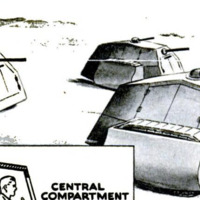A lightweight and low-slung amphibious tank
Item
-
Title (Dublin Core)
-
A lightweight and low-slung amphibious tank
-
Article Title and/or Image Caption (Dublin Core)
-
Caption: Lightweight and low-slung, a new amphibious tank presents a poor target for the enemy's armor-piercing projectiles.
-
extracted text (Extract Text)
-
LIGHTWEIGHT and low-slung, a new
amphibious tank presents a poor target
for the enemy's armor-piercing projec-
tiles. Byron Q. Jones, Fort Knox, Ky.,
designed it, departing from conventional
types by placing the engines in detach-
able units on either side of the central
compartment. Seated in tandem in the
center, the crew operate the high-speed
controls and heavy weapons. Four doors
afford them easy ‘escape should the tank
catch fire or turn over.
DON'T be alarmed. You'll never see any of these
aeronautical monstrosities winging over your
home. Each of them represents what would happen
if one group of specialists in the aircraft industry
had its way in designing the plane as a whole.
The equipment group, for example, thinks that
accessories and gadgets are the most important part
of the plane, Its ideal design would look something
like the flying luxury liner at the right. The power-
plant group would make its plane all engine; the
empennage group, all tail; and so on.
Our drawings by Douglas Rolfe are based on
sketches by C. W. Miller, Vega Aircraft engineer.
The all-glass plane credited to the enclosure group
was the idea (appropriately) of Elmer Lundberg,
design engineer of the Pittsburgh Glass Company.
-
Contributor (Dublin Core)
-
Abbott Griffin (illustrator)
-
Language (Dublin Core)
-
eng
-
Date Issued (Dublin Core)
-
1944-03
-
pages (Bibliographic Ontology)
-
90
-
Rights (Dublin Core)
-
Public Domain (Google digitized)
-
Archived by (Dublin Core)
-
Lorenzo Chinellato
-
Marco Bortolami (editor)
 Popular Science Monthly, v. 144, n. 3, 1944
Popular Science Monthly, v. 144, n. 3, 1944




